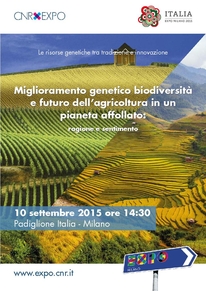Genetic improvement, biodiversity and the future of agriculture in a crowded planet: sense and sensibility

Coordinator: Dr. Alessandro Vitale
Institute of Agricultural Biology and Biotechnology (IBBA)
Interview to Dr. Alessandro Vitale
Which type of event are you organizing for EXPO?
It will be the most important outreach event of an international scientific Congress organized in Milano by the Italian Societies of Agricultural Genetics (www.geneticagraria.it) and Plant Biology (www.sibv.it). The Congress will focus on plant biology and genetic improvement, food production, security and safety, biodiversity and renewable energy sources. The EXPO event is mainly aimed at the various stakeholders across the agricultural sectors and will discuss the contribution of genetics and biotechnology to the improvement of crops,agricultural productivity, quality and sustainability.
Why plant genetic improvement?
To keep pace with world population growth and meet the expectations for better life conditions in developing countries, the quantity and quality of food needs to be markedly improved. However cultivable land cannot be much increased and may actually undergo reductions because of climate changes. Water availability is another major issue. The problem is global and requires multidisciplinary approaches: less crop and food waste, better soil and water management, improved actions to avoid market distortions and excessive price fluctuations, diets with lower environmental impacts, and of course we must accelerate crop genetic improvement.
Do we need a new Green Revolution?
It is ongoing now. Genome sequencing of many crops, including rice, corn, wheat, soybean, common bean, potato, tomato, apple and grape is providing an enormous amount of information useful for agriculture and genetic improvement. The genomes of other plants that are not part of the great crops in terms of quantity but are highly relevant locally are also being sequenced and can lead to further important discoveries in the genetic foundations of our foods.
Why is it useful to sequence plant genomes?
It allows associating desired traits to specific DNA sequences, and helps in defining the roles of different genes. In turn, this speeds up the process of selecting improved crop varieties and makes it more precise. If we know that a specific trait is associated with a given gene, after breeding we do not need to grow many new plants to maturity and then choose those that have that trait, because DNA analysis of the seeds or the new seedlings will quickly tell us which ones to choose.
How can biotechnology allow even more precise plant breeding?
You have to keep in mind that in “classic” breeding many genes are naturally exchanged between the two varieties that have been crossed. Some of them may actually be agronomically or nutritionally undesired but are inherited together with the trait we want to improve. It is therefore necessary to proceed with a series of further crosses and selections, to “clean” the genome of the progeny from these unwanted changes. This is what breeders have been doing since long before molecular biology was born. As I pointed out, the association of specific genes with specific traits can speed up this selection, but a further recent improvement consists in modifying the gene of interest directly in the plant through a precise process that avoids introducing other unwanted modifications in the genome of the improved variety. These “gene editing” strategies have just started to be performed, but clearly open great possibilities.
Which are the advantages of new gene manipulation technologies with respect to GMOs?
Gene editing leaves all genes in their original position in the genome, whereas in “classic” genetic engineering the new gene is inserted more or less randomly. In other words, unlike a GMO, the final product of gene editing can be indistinguishable from a normal breeding result, even if it has been obtained in much shorter time. Of course GMO technologies will still be necessary when there is not enough variability within a given species to allow a new desired trait to be acquired. For example, resistance to a pest for which we do not have resistant varieties of the plant species we want to improve, or nutritional compounds that in a given species are not produced at all.
IN COLLABORATION WITH:
Dr. Poalo Trost (Società Italiana Biologia Vegetale)
Dr. Fabio Veronesi (Società Italiana Genetica Agraria)
Dr. Michele Morgante (Società Italiana Genetica Agraria)
Dr.ssa Chiara Tonelli (Università di Milano)







